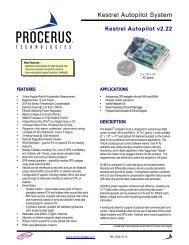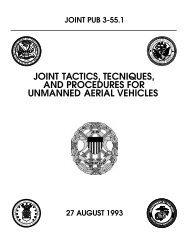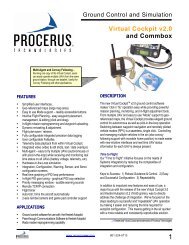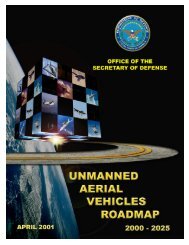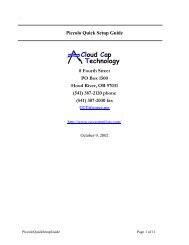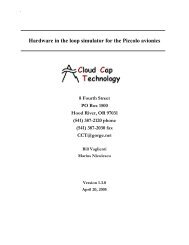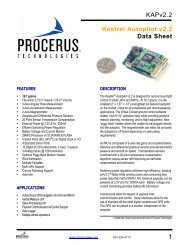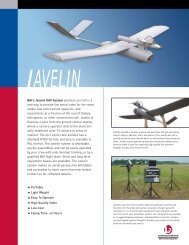Technology Cloud Cap - Unmanned Aircraft & Drones
Technology Cloud Cap - Unmanned Aircraft & Drones
Technology Cloud Cap - Unmanned Aircraft & Drones
You also want an ePaper? Increase the reach of your titles
YUMPU automatically turns print PDFs into web optimized ePapers that Google loves.
<strong>Cloud</strong> <strong>Cap</strong><strong>Technology</strong>PO Box 1500, No 8 Fourth StreetHood River, OR 97031(541) 387-2120 ph (541) 387-2030faxinterface page. If you run into problems or have questions give us a call. Please do not ever tryto fly if you do not have perfect communications!i For a new vehicle the trim settings are typically determined in flight. Hence if you don’t knowthe trim settings you will set them later once the vehicle is flying.ii The altimeter base pressure, also called the altimeter setting, is the atmospheric pressure at sealevel for the current location. It is typically available from the local airport or weather service. Ifyou don’t know the base pressure than use 101325 Pa or 29.92 in-Hg, which is standard pressure.You can still zero the altimeter, but you won’t be able to update the base pressure once theaircraft is flying, hence the barometric altitude will drift with the atmospheric conditions. It isalso possible to update the altimeter setting in real time with the GPS.iii When zeroing the sensors you typically only want to zero the air data, since the inertial sensorsshould be managed by the onboard software. In that case the pitot tube should be shielded fromthe wind (or, at least, turned 90° from it). Ideally you want to wait approximately five minutesafter turning the system on before doing a sensor zero. This gives the avionics time toequilibrate in temperature; which will result in the best sensor zero. You do not have to alwaysperform a zero but you should do so if the dynamic pressure is off by more than 15 Pa. If youwant to zero the inertial sensors then be sure that the avionics is completely level before zeroingall sensors.iv To verify correct gyro operation rotate the aircraft nose right and nose left. Verify the yaw ratesensor indicates positive and negative values respectively. Rotate the aircraft nose up and nosedown. Verify the pitch rate sensor indicates positive and negative values respectively. Rotatethe aircraft roll right and roll left. Verify the roll rate sensor indicates positive and negativevalues respectively.To verify correct accelerometer operation note that when level the X, Y, and Z accelerometersshould read 0,0, and –1 g respectively. With the vehicle rotated 90° right wing down the X,Y,and Z accelerometers should read 0, -1, and 0 g respectively. With the vehicle rotated 90° nosedown the X,Y, and Z accelerometers should read –1, 0, and 0 g respectively.v RSSI is the receive signal strength indicator. It is reported from the radio in units of dBm, andranges from –71 to –115. –71 is the maximum reading. Communications performance willbegin to degrade when the RSSI reaches –101 or lower.Piccolo <strong>Aircraft</strong> Integration Guidelines Page 20 of 20



